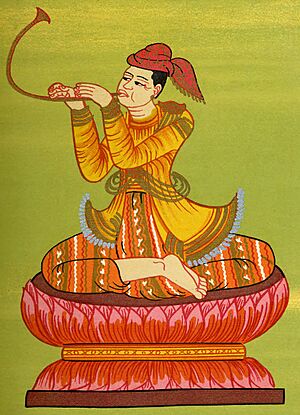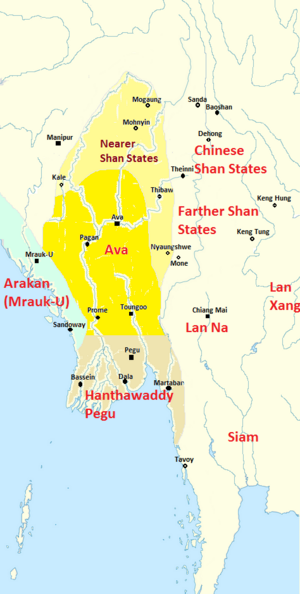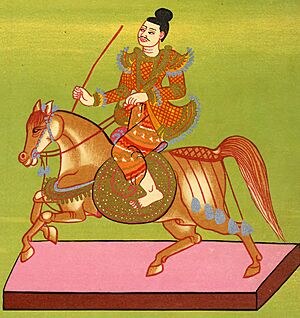Minye Kyawswa facts for kids
Quick facts for kids Minye Kyawswa |
|
|---|---|

Maung Minbyu represented as the Maung Minbyu nat
|
|
| Heir Apparent of Ava | |
| Reign | c. December 1406 – 13 March 1415 |
| Predecessor | Theiddat (Heir Presumptive) |
| Successor | Thihathu |
| Viceroy of Prome | |
| Reign | c. July 1413 – November 1413 |
| Predecessor | Sokkate of Prome (Acting Governor) |
| Successor | Thihathu |
| Born | c. January 1391 c. Tabodwe 752 ME Pyinzi, Ava Kingdom |
| Died | 13 March 1415 (aged 24) Wednesday, 4th waxing of Late Tagu 776 ME Twante–Dala, Hanthawaddy Kingdom |
| Burial | Twante–Dala |
| Spouse | Saw Min Hla (1406–1415) |
| Issue Detail |
|
| Burmese | မင်းရဲကျော်စွာ |
| House | Ava |
| Father | Minkhaung I |
| Mother | Shin Mi-Nauk |
| Religion | Theravada Buddhism |
Minye Kyawswa (born around January 1391 – died March 13, 1415) was a brave crown prince and military leader of the Ava Kingdom. He was the commander-in-chief of Ava's army from 1410 to 1415. People in Burmese history remember him as a very courageous general. He fought the toughest battles of the Forty Years' War (1385–1424) against King Razadarit of the Hanthawaddy Kingdom.
Minye Kyawswa was the son of King Minkhaung I and his most trusted general. From 1406 to 1415, this father-son team fought against all of Ava's neighbors. They almost managed to bring back the old Pagan Empire under Ava's rule. Just when they were close to winning, Minye Kyawswa was hurt in a battle near Twante–Dala. He was captured in March 1415. The young prince refused medical help and died soon after, at only 24 years old.
The stories of Minkhaung and Minye Kyawswa fighting Razadarit are famous legends in Burmese culture. Minye Kyawswa's name is still spoken with respect, just like the greatest warrior kings of Burmese history. He is also honored as a Burmese nat (spirit), known as Maung Minbyu and sometimes as Min Kyawzwa.
Contents
- Early Life and Royal Beginnings
- Becoming a Leader (1400–1410)
- Minye Kyawswa: Commander-in-Chief
- After the Battle
- Legacy and Remembrance
- Commemorations
- Family
- Images for kids
Early Life and Royal Beginnings
Minye Kyawswa was born around January 1391 and was first named Min Phyu. He was the first child of Prince Min Swe and his wife Shin Mi-Nauk. His father was a son of King Swa Saw Ke of Ava. His mother was the daughter of a chief from Mohnyin. His parents married in 1389 or 1390 to help bring peace between Ava and Mohnyin.
Burmese historical records say that Min Phyu was special even before he was born. This was during the first part of the Forty Years' War. People in both Ava and Hanthawaddy believed he was the reincarnation of Prince Bawlawkyantaw of Hanthawaddy. This prince had been executed by his father, King Razadarit, around April 1390. Baw Law Kyan Daw supposedly swore that if he was innocent, he would be reborn in the Ava royal family and cause trouble for Hanthawaddy.
The stories say that a few months after Baw Law Kyan Daw's death, Min Phyu's mother, Mi-Nauk, became pregnant. She craved special foods from the south. Even though Ava and Hanthawaddy were at war, Min Phyu's father, Minkhaung, asked Razadarit to send the food. Razadarit and his court believed the unborn child was Baw Law Kyan Daw reborn. So, Razadarit sent the food.
Min Phyu had a younger sister, Saw Pyei Chantha, and two younger brothers, Thihathu and Min Nyo. They grew up in Pyinzi, a town south of the capital, Ava. In 1400, their father became King Minkhaung, and the family moved to Ava.
Becoming a Leader (1400–1410)
At first, Min Phyu was not the main heir to the throne. His uncle, Theiddat, was more important in the early years of King Minkhaung's rule. But Min Phyu soon started taking on bigger roles. Records say that Min Phyu, now called Minye Kyawswa, led a military campaign in Arakan before he was 12. However, the main invasion of Arakan happened in November 1406.
First Big Campaign in Arakan (1406)
Minye Kyawswa's first confirmed military campaign was in 1406. His father, King Minkhaung, asked his 15-year-old son to lead an army to take over Arakan. This kingdom was on the western coast, separated by mountains. In November 1406, Minye Kyawswa led a large force into Arakan. They advanced to the main fort guarding Launggyet.
His senior officers told him to retreat because the enemy had more soldiers and strong defenses. But the prince insisted on finding a way to attack. Their plan was to trick the Arakanese forces into fighting in an open field. This plan worked. On November 27, 1406, Minye Kyawswa, riding his war elephant, led the attack. Even though Ava's forces were outnumbered, they killed the Arakanese general. After that, the Arakanese defenses fell apart. On November 29, 1406, Ava forces captured Launggyet.
Becoming Crown Prince
This victory showed Minye Kyawswa's skill as a leader. His father made his eldest son the crown prince (the next in line for the throne). He also arranged for Minye Kyawswa to marry Saw Min Hla, who was his cousin.
However, these actions caused problems. In 1407, Minkhaung's brother Theiddat, who was upset about not being chosen as heir, joined forces with Razadarit of Hanthawaddy. In January 1408, Razadarit broke the peace and invaded Arakan. His forces took Launggyet in March 1408. Razadarit had the Ava governor executed and took Minye Kyawswa's sister, Saw Pyei Chantha, as his queen. Both Minkhaung and Minye Kyawswa were very angry. But Minkhaung's attacks on the south in 1408 and 1409–10 were defeated by Razadarit. In 1408, Hanthawaddy forces captured Minye Kyawswa's mother, Queen Mi-Nauk, and Razadarit also took her as his queen.
After these two big defeats, Minye Kyawswa asked to lead the army, and his father agreed. Until then, the crown prince had mostly guarded Ava while his father fought. Now, he was determined to fight Razadarit, who had taken both his sister and his mother.
Minye Kyawswa: Commander-in-Chief
From 1410 to 1415, Minye Kyawswa led Ava's armies with great energy. He almost defeated Hanthawaddy. Ava would not have this much military success again for a long time.
Campaigns in the Irrawaddy Delta (1410–1411)
As commander-in-chief, Minye Kyawswa changed Ava's battle plans. Instead of directly attacking the well-defended Hanthawaddy capital, he decided to attack the Irrawaddy delta, which he thought was less protected. In late 1410, the prince invaded the delta by river and land. His combined forces attacked the important delta cities of Myaungmya and Bassein. But these cities were strongly fortified. Minye Kyawswa decided to retreat to Prome.
Fighting in Arakan (1411–1412)
The prince did not want to go home without a victory. He gathered his forces and invaded Arakan in early 1411. He drove out the rulers that Hanthawaddy had put in place. He appointed new governors for North and South Arakan and returned to Ava.
However, the crown prince was back in Arakan soon after. After the rainy season, two Hanthawaddy armies invaded Arakan. The Ava soldiers at Sandoway were defeated before Minye Kyawswa arrived with more troops. Ava forces then surrounded the city for three months. But they had to leave in early 1412. King Minkhaung called them back to defend against Hsenwi, an ally of Hanthawaddy, which had attacked Ava from the north.
After Ava's troops left, Razadarit sent more soldiers to Sandoway. These Hanthawaddy troops then marched to Launggyet and drove out the Ava soldiers there. Arakan remained under Hanthawaddy's influence.
Defending Against Hsenwi (1412)
Back in Ava, Minye Kyawswa took command of a new army. He immediately marched to the northern front. His job was to protect the nearby Shan states that Ava had taken earlier. The powerful Shan state of Hsenwi was worried about Ava's growing power. Hsenwi had permission from Ming China to fight back against Ava. Hsenwi also became an ally with Hanthawaddy.
Minye Kyawswa's army met the Hsenwi army near Wetwin. They defeated the invaders. The leader of Hsenwi was killed, and many soldiers, horses, and elephants were captured. The prince then chased the enemy all the way to Hsenwi and surrounded the city. The defenders held out, waiting for Chinese reinforcements from Yunnan. Five months into the siege, a Chinese force of 20,000 men arrived. Minye Kyawswa set up an ambush outside the city. The Ava army attacked the larger Chinese army as they came out of the forest. The Chinese army was forced to retreat. Five Chinese commanders and many soldiers and horses were captured. The siege lasted one more month. Around November 1412, King Minkhaung called Minye Kyawswa back to face Razadarit, who had attacked Prome in the south.
Battles at Prome (1412–1413)
Minye Kyawswa quickly sailed from Ava to Prome with his troops. His father had already gone to Prome with another army. When Minye Kyawswa arrived, father and son tried to break through the Hanthawaddy lines. They didn't make much progress for about four months. Then, Hanthawaddy lost its two most important generals. First, General Byat Za died from a long illness. Soon after, General Lagun Ein was badly wounded in a naval battle and captured by Ava's navy. When Lagun Ein died from his wounds, Minye Kyawswa ordered his body to be sent down the Irrawaddy River with full military honors. Razadarit was shaken by these deaths and quickly retreated.
Pushing Towards Dagon and Dala (1413)
Minye Kyawswa suggested invading the south right away. While King Minkhaung was unsure, he allowed his son to go ahead. In April 1413, Minye Kyawswa captured the eastern delta towns of Dala–Twante and Dagon. But Ava's advance stopped at the battle of Hmawbi, where a key general was badly wounded. Minkhaung ordered a pause because the rainy season was near, and the army was tired. The crown prince ignored his father's order and continued marching towards Pegu in May 1413.
However, Hanthawaddy's defenses were ready. Minye Kyawswa's army was pushed back outside Dala by three of Razadarit's sons. Another Ava army was also defeated. Minye Kyawswa decided to wait out the rainy season in Prome, where he became the acting viceroy. Razadarit, for his part, decided to wait until after the monsoon season to attack Dala. Instead, he sent messengers to northern Shan states to find allies.
Northern Front and Last Invasion (1413–1414)
Ava's northern border was never truly peaceful after the siege of Hsenwi. In 1413, while Ava's main armies were in the south, Chinese-backed Hsenwi forces attacked Ava's northern lands. They destroyed many towns. According to Burmese records, another Shan state, Maw, also attacked Myedu. In response, King Minkhaung called Minye Kyawswa back to Ava. He sent his middle son, Thihathu, to Prome to take over. The southern Ava army also left Dala. In Ava, Minye Kyawswa took command of a large army and marched to Myedu. His forces defeated Maw forces and chased them to the Chinese border.
Final Invasion of Hanthawaddy (1414–1415)
The Ava leaders thought their victory in the north was complete. So, they planned a full-scale invasion of the south. Minye Kyawswa's plan was to attack the western Irrawaddy delta first. Then, he would attack the eastern delta towns of Dala and Dagon before marching on to Pegu. Ava gathered its largest invasion force ever for this campaign.
Battles in the Irrawaddy Delta
Around October 1414, Minye Kyawswa launched the invasion. They attacked Fort Khebaung (north of Hinthada) by both land and sea. But Hanthawaddy troops defended bravely, causing many losses for Ava. After two failed attempts, Minye Kyawswa ordered another attack. He declared that anyone who failed to charge would be executed. Then, he, riding his favorite war elephant, led the charge with his best soldiers. The fort eventually fell. The fall of Khebaung surprised Razadarit, who had spent a lot of money on its defenses. He immediately sent an army to retake Khebaung.
Ava forces then spread throughout the delta. However, they could not take Bassein or Myaungmya, the two main cities in the western delta. They found themselves spread too thin because Hanthawaddy forces kept attacking their supply lines. Even so, they fought off a combined land and naval attack by Hanthawaddy forces from Pegu. They captured General Smin Bayan, a son-in-law of Razadarit, and 20 other senior commanders. This victory helped Ava's supply lines, allowing the sieges of Bassein and Myaungmya to continue.
The crown prince began preparing for the next stage: marching towards Pegu itself. But he needed to convince his father first. He made a 17-day trip back to Ava, bringing the captured Hanthawaddy commanders with him. In Ava, he discussed the war with his father. A week later, he sailed back south. As he expected, Bassein surrendered soon after his return, and Myaungmya followed. By December 1414, the entire delta was under Ava's control.
Pushing into Pegu Province
Minye Kyawswa wrote to King Minkhaung, saying that Razadarit had not returned to Pegu, and it was the right time to attack. Minkhaung tried to warn his son that it might be a trap. The king ordered his son Thihathu and another governor to attack Fort Sayat from the north. Before this attack could happen, Minye Kyawswa launched an attack on both Syriam (Thanlyin) and Dagon (Yangon).
However, the planned attack on Sayat was delayed because Chinese forces invaded from the north. Minkhaung managed to send an army that forced the Chinese army to retreat. Meanwhile, Razadarit returned to Pegu in January or February 1415. The Chinese threat forced Minkhaung to send fewer troops to Sayat. After Thihathu's weak attack on Sayat, Razadarit focused on the Dala–Syriam area. On February 22, 1415, the Pegu leaders made a plan to fight Minye Kyawswa. Eight days later, on March 2, 1415, Razadarit himself led the army to the front.
The Final Battle of Dala
The Hanthawaddy leaders planned to fight on March 13, 1415. On that day, Hanthawaddy forces, led by three of Razadarit's sons, approached modern Dala–Twante. Minye Kyawswa pulled back from his siege of Syriam to meet the enemy. His brother Min Nyo was his second-in-command. Minye Kyawswa, riding his favorite elephant, led the charge. He broke through several enemy lines but was soon surrounded. His elephant, which was badly wounded, threw him off. Although severely injured, the crown prince of Ava refused treatment and died shortly after. He was only 24 years old.
After the Battle
Razadarit gave Minye Kyawswa a burial with full royal honors. King Minkhaung immediately came with an army and dug up his son's body from where Razadarit had buried him. The remains were respectfully placed into the waters near Twante. After causing damage throughout the delta, Minkhaung called off the invasion and left. In Ava, Minkhaung appointed Thihathu as the new crown prince in 1415. He also married Minye Kyawswa's widow, Saw Min Hla, to Thihathu.
Minye Kyawswa was deeply respected by both sides for his courage. His campaigns in 1414–1415 were the most important part of the Forty Years' War. After his death, the war quickly died down. Only three more campaigns were fought half-heartedly by both sides. Ava's military success was mostly due to Minye Kyawswa's inspiring leadership. Ava would not see this kind of success again.
Legacy and Remembrance
The stories of King Minkhaung and Minye Kyawswa fighting Razadarit are famous legends in Burmese popular culture. Minye Kyawswa's name is still spoken alongside the names of the greatest warrior kings in Burmese history. He also became part of the group of Burmese nats (spirits) as Maung Minbyu, which was his birth name. In some stories, he is also known as the Min Kyawzwa nat.
Commemorations
- Minye Kyawswa Road, a road in Yangon
Family
Minye Kyawswa was married to Saw Min Hla. They had four children:
- Minye Kyawhtin of Toungoo (1408–1459) – He later became a rebel "King" of Toungoo.
- Min Hla Htut of Pyakaung (around 1410–?) – She was the wife of Viceroy Sithu Kyawhtin of Toungoo and grandmother of King Mingyi Nyo of the Toungoo Dynasty.
- Minye Aung Naing (around 1412–?)
- Saw Min Phyu (1415–?) – She was the third wife of a governor and grandmother of King Bayin Htwe of Prome.
Images for kids






